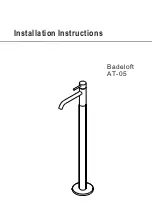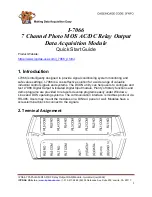
Glossary
G-6
ni.com
data transfer
A technique for moving digital data from one system to another.
Options for data transfer are DMA, interrupt, and programmed I/O. For
programmed I/O transfers, the CPU in the PC reads data from the DAQ
device whenever the CPU receives a software signal to acquire a single data
point. Interrupt-based data transfers occur when the DAQ device sends an
interrupt to the CPU, telling the CPU to read the acquired data from the
DAQ device. DMA transfers use a DMA controller, instead of the CPU, to
move acquired data from the device into computer memory. Even though
high-speed data transfers can occur with interrupt and programmed I/O
transfers, they require the use of the CPU to transfer data. DMA transfers
are able to acquire data at high speeds and keep the CPU free for
performing other tasks at the same time.
dB
Decibel—The unit for expressing a logarithmic measure of the ratio of two
signal levels: dB = 20log10 V1/V2, for signals in volts.
DC
Direct current—although the term speaks of current, many different types
of DC measurements are made, including DC Voltage, DC current, and DC
power.
device
A plug-in data acquisition product, card, or pad that can contain multiple
channels and conversion devices. Plug-in products, PCMCIA cards, and
devices such as the DAQPad-1200, which connects to your computer
parallel port, are all examples of DAQ devices. SCXI modules are distinct
from devices, with the exception of the SCXI-1200, which is a hybrid.
DIFF
Differential mode—An analog input mode consisting of two terminals,
both of which are isolated from computer ground, whose difference is
measured.
differential input
An input circuit that actively responds to the difference between two
terminals, rather than the difference between one terminal and ground.
Often associated with balanced input circuitry, but also may be used with
an unbalanced source.
digital I/O
The capability of an instrument to generate and acquire digital signals.
Static digital I/O refers to signals where the values are set and held, or
rarely change. Dynamic digital I/O refers to digital systems where the
signals are continuously changing, often at multi-MHz clock rates.
digital isolator
Provides voltage isolation between its input and output.
















































